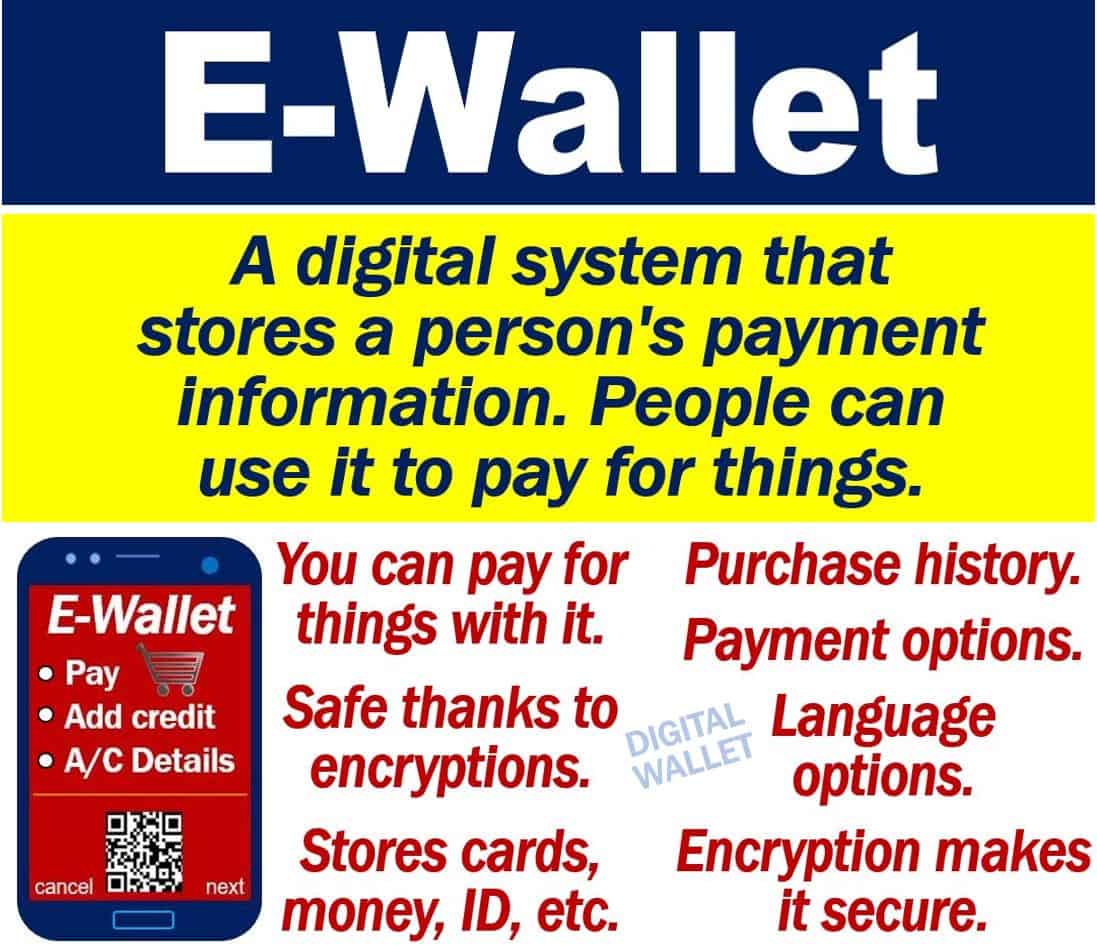An e-wallet is a digital system that stores a person’s payment information. ‘Digital’ means it exists purely electronically. It is a secure, online wallet. The term is short for ‘electronic wallet,’ i.e., the ‘e’ of e-wallet stands for ‘electronic.’ We also call it a digital wallet.
The e-wallet stores users’ cards digitally so that they can buy things electronically, i.e., online. If you have this kind of wallet, you can pay for things online using your laptop, tablet, or smartphone.
You can also use your digital wallet to pay for things in some cafes and shops that you physically visit.
Some e-wallets store your loyalty cards, insurance cards, and driver’s license. They can also store your health card plus other IDs that you’d normally keep in a traditional wallet.
An e-wallet may also refer to where people store their cryptocurrencies, i.e., it may mean a cryptocurrency wallet.
A cryptocurrency is a type of digital money, i.e., money that exists purely online. Bitcoin, for example, is a cryptocurrency.

E-wallet – why have one?
E-wallets aim to eliminate the need for people to carry traditional wallets. Their biggest advantage, so claim e-wallet creators, is security.
It is far more difficult to steal a digital wallet than a traditional one.
Even though it is supposedly more secure, e-wallet owners lose some of their privacy.
Traditional wallets to not track our purchases. They do not have information on our shopping habits. E-wallets do, i.e., they keep records of what you bought.
Companies can get hold of that data. It is useful for marketing executives because then they know who to target with, for example, specific advertisements.
What is an e-wallet made of?
E-wallets consist of two things:
- The data, and
- the software.
Data
Data is all the information that the digital wallet user provides. This includes the user’s address, card details, and name.
Software
Software, i.e., computer programs, makes sure that the wallet stores all the information properly. The software also secures the data by encrypting it.
To be able to use your digital wallet, you must install the software in your electronic device first. Without it, your wallet is useless.
When you have installed the software, it then gathers all the relevant data and stores it.
E-wallet transaction processes
E-wallets do not all have the same transaction process. The process that each wallet uses depends on the software that makes it function.
With some wallets, you have to insert your password to confirm a transaction.
Other wallets, on the other hand, may give the user a unique identification code for each transaction.
Many companies continue to offer their own digital wallets, with Apple Pay providing seamless integration for Apple device users, Cash App catering to instant transactions and Bitcoin trading, Samsung Pay specializing in digital payments for Samsung device users, Google Pay serving Android users with contactless payments and peer-to-peer transfers, and PayPal remaining a robust platform for both personal and business transactions globally.
E-wallets often provide a quicker checkout process, reducing the time spent on completing online transactions.
This video presentation, from our sister channel in YouTube – Marketing Business Network, explains what an “e-wallet” is using simple and easy-to-understand language and examples.
